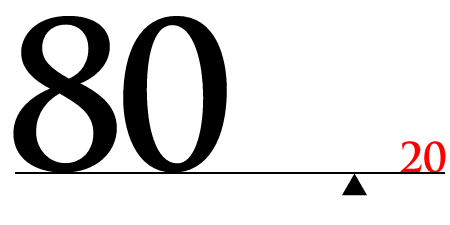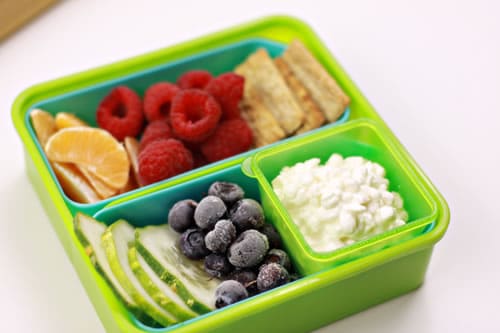The 80/20 Rule
Oct 18, 2010, Updated Jun 18, 2014
Daniel Koontz is the author of Casual Kitchen, a blog helping readers cook more, think more, and spend less. Today he shares some thoughts on the “80/20 Rule” (also known as the Pareto Principle) and how you can apply it in your life to powerful effect.
If you just discovered October: Unprocessed, go here to find out more and take the pledge. Don’t worry if you missed the start date! You can start your 30 days today, or simply join in for the rest of the month.
 One of the most powerful rules I discuss on my website is the 80/20 Rule. It’s an extraordinarily effective way to help make your eating and cooking habits healthier, more efficient and less expensive.
One of the most powerful rules I discuss on my website is the 80/20 Rule. It’s an extraordinarily effective way to help make your eating and cooking habits healthier, more efficient and less expensive.
The logic of 80/20 is this: The majority of the output of a system is usually driven by a small number of inputs. Usually, people think of this concept in business settings, as in how 75% of sales come from 25% of a company’s clients, or 90% of the defects in a manufacturing plant might come from a very small number of root causes.
In its most basic sense, however, the 80/20 rule suggests that in most cases, adjusting or changing just a few critical inputs can unleash powerful results with surprisingly little effort. And when it comes to our diets and food, the 80/20 Rule manifests in situations like these:
1) Some 80% of your excess calories come from roughly 20% of the foods you eat. Thus making just one or two key dietary changes could help you dramatically reduce your caloric intake.
2) You will find that most of your “bad eating” can be elimated by making one or two minor habit changes, such as avoiding mindless eating sessions in front of the TV, or not keeping a stash of junk food in your home.
When I heard about Andrew’s October: Unprocessed event, I knew immediately that this would be yet another way to put the 80/20 Rule to excellent use. Why? Because processed foods represent the 80/20 Rule on steroids.
Here are some all-too-typical examples:
1) Those two glazed donuts you just ate represent a massive percentage of your fat intake for the day.
2) That canned, processed soup you just served your kids represents — in just one bowl — some 80% of their daily requirement of sodium.
3) The overwhelming majority of our most gluttonous overeating experiences invariably come when we’re eating processed foods engineered specifically to be both hyperpalatable and rapidly eaten.
4) Sugar- and High Fructose Corn Syrup-laden beverages are a vast source of empty and easily-ingested calories. Replace these beverages with simple, zero-calorie tap water and you’ll effortlessly reduce your caloric intake.
5) Processed foods, especially those that are branded and heavily advertised, typically represent some of the worst values in your entire grocery store. Cut out a few key processed food purchases and you’ll significantly reduce the cost and improve the health content of the food you buy.
What does all of this mean? It means that the ridiculously simple step of reducing your consumption of processed foods will unleash enormous improvements in your diet, your fitness, and your life. Try it!
What examples of 80/20 thinking have you put to work in your diet? Share your thoughts in the comments!




















Great post – this has been a slow “process” for me, trying to eat better, cleaner, etc. It’s funny, because my body is really responding. I don’t ever crave the sodas and chips any more. I just went on a trip — ate very well for the most part — except during the “travel” part. I couldn’t wait to come home and cook some real food. That is a HUGE change for me! Thanks again ~
Loved this post. The 80/20 rule helps me (try) to avoid being legalistic/food Nazi with feedingmmy family. If we are eating well at home 80% of the time, then I don’t need to get bent out of shape if we have a treat every now and then out of the house. The 80/20 rule helps me keep perspective, and focus more on my relationships instead of micro-managing every bite that goes in my children’s mouths. Thanks!
Melissa, thank you! You’ve cited a great example that I neglected to mention. It’s deceivingly easy to ingest calories via beverages we consume, and sweetened coffee beverages are among the worst offenders. Great insight.
Anita, I love it. Thanks for sharing just a perfect expression. If anything, practicing moderation in your moderation will help you stick to generally good habits and help you avoid going on a serious junk food bender. Sometimes (but not too often!) you just need to satisfy the craving. Thank you.
I use another sort of 80/20 rule: I pay attention to what I eat 80% of the time, and the other 20% I eat what I’m craving. Everything in moderation — including moderation.
Mindless + craving for sugar = 80% of your sugar and half your calories for the day in that sweet coffee drink you get in the morning. That’s a big one people tend to overlook.
This is great thinking Dan. Glad to see your post here!
Tara, thanks for chiming in. Believe it or not, you CAN do the “processing” yourself and make really delicious homemade potato chips. Try it and see what you think! I think you could technically fit this into Andrew’s challenge. 😉
Lewy, glad to hear it. Have you ever read David Kessler’s The End of Overeating? I strongly recommend it: it helped me understand the many perceptual things that happen to our tastebuds and our brains when we eat processed foods. I’m sure the book has come up elsewhere here at Eating Rules, but if you’re curious to learn more, I’ve also written a rabidly positive review of the book at Casual Kitchen. Just search my Index of Posts page.
Point #3 is a recent revelation to me. I noticed one day how I can tear through a bunch of homemade baked sweet potato fries smothered in salt and ketchup, but when I leave the salty, processed condiments in the fridge I find I eat slower and with more enjoyment of the real flavor and texture of my food. It’s the same for any processed foods – they are just tricking our taste buds into thinking they’re flavorful and satisfying.
Thanks for your post, it definitely reassured me that I’m doing well even though I’m not sticking to being 100% unprocessed. My only big “offences” are potato chips (NOT big-branded, at least) and cereal which I also try to stick with smaller, relatively local brands; I’m a bit of a Seinfeld when it comes to cereal selection at my house.
I’m ok with calorie-dense foods, as long as they are whole and in reasonable portions – our bodies need them.
Nancy, thank you for adding that context. Agreed, you can easily use the same 80/20 logic with calorie-dense foods–whether made at home or consumed outside of the home.
Hello Daniel,
You’ve made some good points here. However, I would like to add that it isn’t just “processed foods” that are the issue but calorie dense foods. Home made “unprocessed” foods can carry just as high (or higher) calorie counts as their “processed” counterparts.